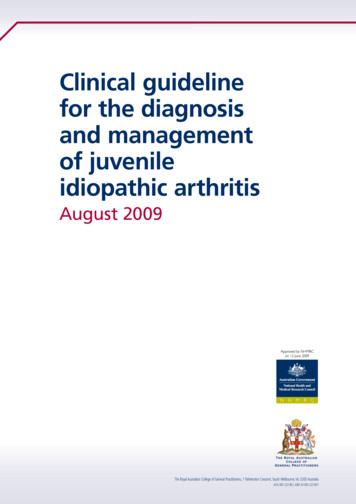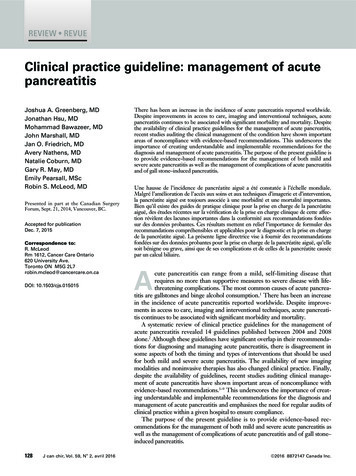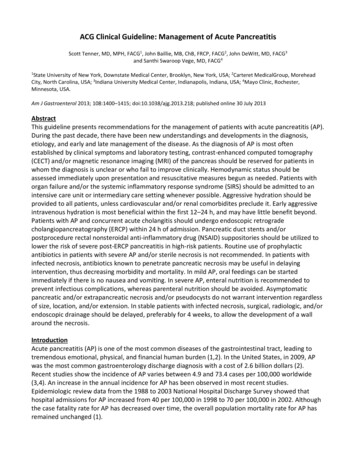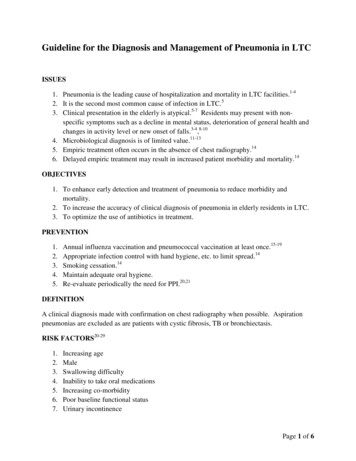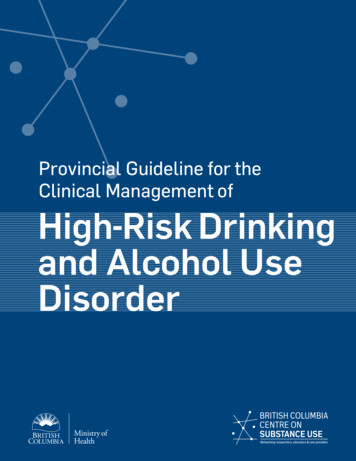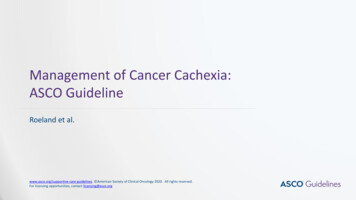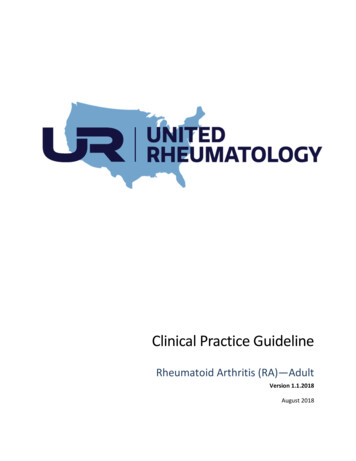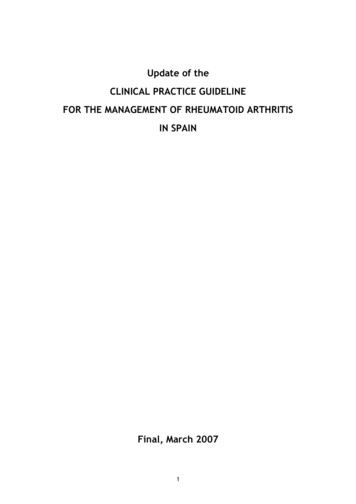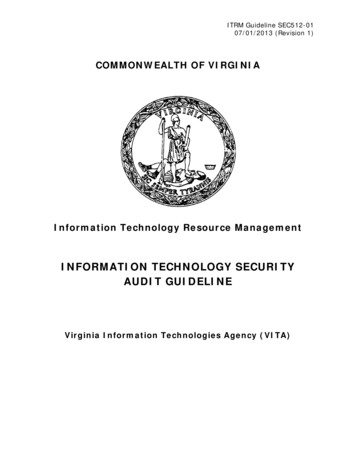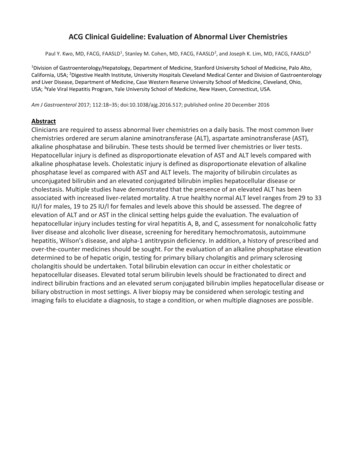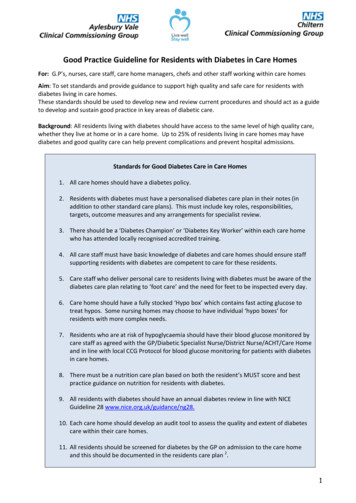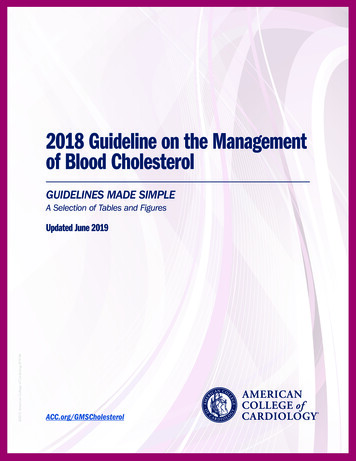
Transcription
2018 Guideline on the Managementof Blood CholesterolGUIDELINES MADE SIMPLEA Selection of Tables and Figures 2019, American College of Cardiology B19146Updated June 2019ACC.org/GMSCholesterol
2018 Guideline on the Management of Blood CholesterolGUIDELINES MADE SIMPLEA report of the American College of Cardiology/American Heart AssociationTask Force on Clinical Practice GuidelinesWriting Committee:Scott M. Grundy, MD, PhD, FAHA, ChairNeil J. Stone, MD, FACC, FAHA, Vice ChairAlison L. Bailey, MD, FACC, FAACVPRCraig Beam, CREKim K. Birtcher, MS, PharmD, AACC, FNLARoger S. Blumenthal, MD, FACC, FAHA, FNLALynne T. Braun, PhD, CNP, FAHA, FPCNA, FNLASarah de Ferranti, MD, MPHJoseph Faiella-Tommasino, PhD, PA-CDaniel E. Forman, MD, FAHARonald Goldberg, MDPaul A. Heidenreich, MD, MS, FACC, FAHAMark A. Hlatky, MD, FACC, FAHADaniel W. Jones, MD, FAHADonald Lloyd-Jones, MD, SCM, FACC, FAHANuria Lopez-Pajares, MD, MPHChiadi E. Ndumele, MD, PhD, FAHACarl E. Orringer, MD, FACC, FNLACarmen A. Peralta, MD, MASJoseph J. Saseen, PharmD, FNLA, FAHASidney C. Smith, Jr, MD, MACC, FAHALaurence Sperling, MD, FACC, FAHA, FASPCSalim S. Virani, MD, PhD, FACC, FAHAJoseph Yeboah, MD, MS, FACC, FAHAThe purpose of the present guideline is to address the practical management of patients with highblood cholesterol and related disorders. The 2018 Cholesterol Guideline is a full revision of the 2013ACC/AHA Guideline on the Treatment of Blood Cholesterol to Reduce Atherosclerotic CardiovascularRisk in Adults.The following resource contains tables and figures from the 2018 Guideline for the Management ofBlood Cholesterol. The resource is only an excerpt from the Guideline and the full publication shouldbe reviewed for more tables and figures as well as important context.CITATION: J Am Coll Cardiol. Nov 2018; DOI: 10.1016/j.jacc.2018.11.003
2018 Guideline on the Management of Blood CholesterolGUIDELINES MADE SIMPLESelected Table or FigurePageTop Ten Messages to Reduce Risk of ASCVD 4-6ACC JACC Central Illustration: Overview of Primary and Secondary ASCVD Prevention 7Four Statin Benefit Groups:1. Secondary ASCVD Prevention- Clinical ASCVD: Figure 1 8- Criteria for Very High Risk ASCVD 92. Severe Hypercholesterolemia (LDL-C 190)- Recommendations for Primary Severe Hypercholesterolemia[LDL-C 190 mg/dL ( 4.9 mmol/L)] 103. Diabetes Mellitus in Adults 40-75 Years of Age With LDL- C 70-189 mg/dL- Risk Enhancers That Are Independent of Other Risk Factors in Diabetes 114. Primary Prevention Over the Life Span- Primary Prevention: Figure 2 12- Risk-enhancing Factors for Clinician-Patient Risk Discussion 13- Checklist for Clinician-Patient Shared Decision Making for Initiating Therapy 14- Selected Examples of Candidates for Coronary Artery Calcium Who Might Benefitfrom Knowing CAC 0 (In Selected patients if Risk Decision Uncertain) 15Treatment Considerations: High-, Moderate-, and Low-Intensity Statin Therapy 16 Statin Associated Side Effects (SASS) 17-18Special Populations: Normal and Abnormal Lipid Values in Childhood 19 Ethnicity Issues in Evaluation, Risk Decisions, and Treatment of ASCVD Risk 20-22
GUIDELINES MADE SIMPLEChol 2018 Guideline on the Management of Blood CholesterolBack to Table of ContentsTop 10 Take-Home Messages to Reduce Risk of AtheroscleroticCardiovascular Disease (ASCVD) through Cholesterol Management1(1 of 3)In all individuals, emphasize heart-healthy lifestyleacross the life-course.A healthy lifestyle reduces atherosclerotic cardiovascular disease (ASCVD) risk at all ages. In younger individuals, healthylifestyle can reduce development of risk factors and is the foundation of ASCVD risk reduction. In young adults 20 to39 years of age, an assessment of lifetime risk facilitates the clinician–patient risk discussion (see #6) and emphasizesintensive lifestyle efforts. In all age groups, lifestyle therapy is the primary intervention for metabolic syndrome.2In patients with clinical ASCVD, reduce low-densitylipoprotein cholesterol (LDL-C) with high-intensity statintherapy or maximally tolerated statin therapyThe more LDL-C is reduced on statin therapy, the greater will be subsequent risk reduction. Use a maximally toleratedstatin to lower LDL-C levels by 50%.3In very high-risk ASCVD, use a LDL-C threshold of 70 mg/dL(1.8 mmol/L) to consider addition of nonstatins to statin therapy.Very high-risk includes a history of multiple major ASCVD events or 1 major ASCVD event and multiple high-riskconditions. In very high-risk ASCVD patients, it is reasonable to add ezetimibe to maximally tolerated statin therapywhen the LDL-C level remains 70 mg/dL ( 1.8 mmol/L). In patients at very high risk whose LDL-C level remains 70 mg/dL ( 1.8 mmol/L) on maximally tolerated statin and ezetimibe therapy, adding a PCSK9 inhibitor is reasonable, although the long-term safety ( 3 years) is uncertain and cost effectiveness is low at mid-2018 list prices.4In patients with severe primary hypercholesterolemia (LDL-Clevel 190 mg/dL [ 4.9 mmol/L]), without calculating 10-yearASCVD risk, begin high-intensity statin therapy.If the LDL-C level remains 100 mg/dL ( 2.6 mmol/L), adding ezetimibe is reasonable. If the LDL-C level on statinplus ezetimibe remains 100 mg/dL ( 2.6 mmol/L) and the patient has multiple factors that increase subsequentrisk of ASCVD events, a PCSK9 inhibitor may be considered, although the long-term safety ( 3 years) is uncertainand economic value is uncertain at mid-2018 list prices.“Top Ten Messages” is continued in the next page.4
GUIDELINES MADE SIMPLEChol 2018 Guideline on the Management of Blood CholesterolBack to Table of ContentsTop 10 Take-Home Messages to Reduce Risk of AtheroscleroticCardiovascular Disease (ASCVD) through Cholesterol Management(2 of 3)5In patients 40 to 75 years of age with diabetes mellitus andLDL-C 70 mg/dL ( 1.8 mmol/L), start moderate-intensitystatin therapy without calculating 10-year ASCVD risk.In patients with diabetes mellitus at higher risk, especially those with multiple risk factors or those 50 to 75years of age, it is reasonable to use a high-intensity statin to reduce the LDL-C level by 50%.6In adults 40 to 75 years of age evaluated for primaryASCVD prevention, have a clinician–patient risk discussionbefore starting statin therapy.Risk discussion should include a review of major risk factors (e.g., cigarette smoking, elevated blood pressure,LDL-C, hemoglobin A1C [if indicated], and calculated 10-year risk of ASCVD); the presence of risk-enhancing factors(see #8); the potential benefits of lifestyle and statin therapies; the potential for adverse effects and drug–druginteractions; consideration of costs of statin therapy; and patient preferences and values in shared decision-making.7In adults 40 to 75 years of age without diabetes mellitus andwith LDL-C levels 70 mg/dL ( 1.8 mmol/L), at a 10-yearASCVD risk of 7.5%, start a moderate-intensity statin if adiscussion of treatment options favors statin therapy. Risk-enhancing factors favor statin therapy (see #8). If risk status is uncertain, consider using coronary arterycalcium (CAC) to improve specificity (see #9). If statins are indicated, reduce LDL-C levels by 30%, and if 10year risk is 20%, reduce LDL-C levels by 50%.“Top Ten Messages” is continued in the next page.5
GUIDELINES MADE SIMPLEChol 2018 Guideline on the Management of Blood CholesterolBack to Table of ContentsTop 10 Take-Home Messages to Reduce Risk of AtheroscleroticCardiovascular Disease (ASCVD) through Cholesterol Management(3 of 3)8In adults 40 to 75 years of age without diabetes mellitus and10-year risk of 7.5% to 19.9% (intermediate risk), risk-enhancing factors favor initiation of statin therapy (see #7).Risk-enhancing factors include family history of premature ASCVD; persistently elevated LDL-C levels 160 mg/dL( 4.1 mmol/L); metabolic syndrome; chronic kidney disease; history of preeclampsia or premature menopause(age 40 years); chronic inflammatory disorders (e.g., rheumatoid arthritis, psoriasis, or chronic HIV); high-riskethnic groups (e.g., South Asian); persistent elevations of triglycerides 175 mg/dL ( 1.97 mmol/L); and, ifmeasured in selected individuals, apolipoprotein B 130 mg/dL, high-sensitivity C-reactive protein 2.0 mg/L,ankle-brachial index 0.9 and lipoprotein (a) 50 mg/dL or 125 nmol/L, especially at higher values of lipoprotein (a). Risk-enhancing factors may favor statin therapy in patients at 10-year risk of 5-7.5% (borderline risk).9In adults 40 to 75 years of age without diabetes mellitus andwith LDL-C levels 70 mg/dL- 189 mg/dL ( 1.8-4.9 mmol/L),at a 10-year ASCVD risk of 7.5% to 19.9%, if a decision aboutstatin therapy is uncertain, consider measuring CAC.If CAC is zero, treatment with statin therapy may be withheld or delayed, except in cigarette smokers, those withdiabetes mellitus, and those with a strong family history of premature ASCVD. A CAC score of 1 to 99 favors statintherapy, especially in those 55 years of age. For any patient, if the CAC score is 100 Agatston units or 75th percentile, statin therapy is indicated unless otherwise deferred by the outcome of clinician–patient risk discussion.10Assess adherence and percentage response to LDL-C–loweringmedications and lifestyle changes with repeat lipid measurement4 to 12 weeks after statin initiation or dose adjustment, repeated every 3 to 12 months as needed.Define responses to lifestyle and statin therapy by percentage reductions in LDL-C levels compared with baseline. In ASCVD patients at very high-risk, triggers for adding nonstatin drug therapy are defined by thresholdLDL-C levels 70 mg/dL ( 1.8 mmol/L) on maximal statin therapy (see #3).6
GUIDELINES MADE SIMPLEChol 2018 Guideline on the Management of Blood CholesterolBack to Table of ContentsOverview of Primary and Secondary ASCVD PreventionThis tool provides a broad overview of the 2018 Cholesterol Guideline.Please refer to the full guideline document for specific recommendations.The ACC Cholesterol Guideline ClinicalTool Work Group decided to remove theOverview of Primary and SecondaryASCVD Prevention tool in order tominimize confusion about the full rangeof information covered in the guideline.7
Back to Table of ContentsGUIDELINES MADE SIMPLEChol 2018 Guideline on the Management of Blood CholesterolSecondary ASCVD PreventionFirst Statin Benefit GroupFigure 1:Secondary Prevention in Patients with Clinical ASCVDClinicalASCVDHealthy LifestyleASCVD not at very high-risk*Age 75 yrsVery high-risk* ASCVDHigh-intensity or maximal statin(Class I)Age 75High-intensity statin(Goal: LDL-C 50%)(Class I)If highintensitystatin nottolerated,usemoderateintensitystatin(Class I)If onmaximal statin& LDL-C 70mg/dL( 1.8 mmol/L),addingezetimibemay bereasonable(Class IIb)Initiation ofmoderate orhigh-intensitystatin isreasonable(Class IIa)Continuationofhigh-intensitystatin isreasonable(Class IIa)If on maximalstatin &LDL-C 70mg/dL( 1.8 mmol/L),addingezetimibe isreasonable(Class IIa)If PCSK9-Iis considered,add ezetimibeto maximalstatin beforeaddingPCSK9-I(Class I)Dashed arrowindicatesRCT-supportedefficacy,but is lesscost effectiveIf on clinically judged-maximal LDL-C loweringtherapy & LDL-C 70 mg/dL ( 1.8 mmol/L),or non-HDL-C 100 mg/dL ( 2.6 mmol/L),adding PCSK9-I is reasonable(Class IIa)*Very high-risk includes a history of multiple major ASCVD events or 1 major ASCVD event and multiple high-risk conditions (Table 4 onfollowing page).Figure 18
GUIDELINES MADE SIMPLEChol 2018 Guideline on the Management of Blood CholesterolBack to Table of ContentsSecondary ASCVD PreventionFirst Statin Benefit GroupVery High-Risk for Future ASCVD Events*Table 4Major ASCVD EventsRecent acute coronary syndrome (within the past 12 months)History of myocardial infarction (other than recent acute coronary syndrome event listed above)History of ischemic strokeSymptomatic peripheral arterial disease (history of claudication with ankle brachial index 0.85,or previous revascularization or amputation)High-Risk ConditionsAge 65 yearsHeterozygous familial hypercholesterolemiaHistory of prior coronary artery bypass surgery or PCI outside of the major ASCVD event(s)Diabetes MellitusHypertensionChronic kidney disease (eGFR 15-59 mL/min/1.73 m2)Current smokingPersistently elevated LDL-C (LDL-C 100 mg/dL ( 2.6 mmol/L)) despite maximally toleratedstatin therapy and ezetimibeHistory of congestive heart failure*Very High Risk includes a history of multiple major ASCVD events or one major ASCVD event and multiple high-risk conditions.9
GUIDELINES MADE SIMPLEChol 2018 Guideline on the Management of Blood CholesterolBack to Table of ContentsSevere HypercholesterolemiaSecond Statin Benefit GroupRecommendations for Primary Severe Hypercholesterolemia[LDL-C 190 mg/dL ( 4.9 mmol/L)]CORLOEIB-R1. In patients 20 to 75 years of age with an LDL-C level of 190 mg/dLor higher, ( 4.9 mmol/L) maximally tolerated statin therapy isrecommended.B-R2. In patients 20 to 75 years of age with an LDL-C level of 190 mg/dLor higher ( 4.9 mmol/L) who achieve less than 50% reduction inLDL-C while receiving maximally tolerated statin therapy and/or havean LDL-C level of 100 mg/dL ( 2.6 mmol/L) or higher, ezetimibetherapy is reasonable.B-R3. In patients 20 to 75 years of age with a baseline LDL-C 190 mg/dLor higher ( 4.9 mmol/L), who achieve less than a 50% reductionin LDL-C levels and have fasting triglycerides 300 mg/dL or lower( 3.4 mmol/L) while taking maximally tolerated statin and ezetimibetherapy, the addition of a bile acid sequestrant may be considered.B-R4. In patients 30 to 75 years of age with heterozygous FH and with anLDL-C level of 100 mg/dL or higher ( 2.6 mmol/L) while takingmaximally tolerated statin and ezetimibe therapy, the addition of aPCSK9 inhibitor may be considered.C-LD5. In patients 40 to 75 years of age with a baseline LDL-C level of 220mg/dL or higher ( 5.7 mmol/L) who achieve an on-treatment LDL-Clevel of 130 mg/dL or higher ( 3.4 mmol/L) while receivingmaximally tolerated statin and ezetimibe therapy, the addition of aPCSK9 inhibitor may be considered.IIaIIbIIbIIbValue Statement:Uncertain Value(B-NR)Recommendations6. Among patients with FH without evidence of clinical ASCVD takingmaximally tolerated statin and ezetimibe therapy, PCSK9 inhibitorsprovide uncertain value at mid-2018 US list prices.10
GUIDELINES MADE SIMPLEChol 2018 Guideline on the Management of Blood CholesterolBack to Table of ContentsDiabetes Mellitus in AdultsThird Statin Benefit GroupDiabetes-specific Risk EnhancersThat Are Independent of Other Risk Factors in DiabetesTable 5 Long duration ( 10 years for type 2 diabetes or 20 years for type 1 diabetes) Albuminuria 30 mcg albumin/mg creatinine eGFR 60 ml/min/1.73 m2 Retinopathy Neuropathy ABI 0.911
Back to Table of ContentsGUIDELINES MADE SIMPLEChol 2018 Guideline on the Management of Blood CholesterolPrimary Prevention Over The Life SpanFourth Statin Benefit GroupPrimary PreventionLDL-C 190 mg/dL ( 4.9 mmol/L)No risk assessment; Highintensity statin(Class I)Primary Prevention:Assess ASCVD Risk in Each Age GroupEmphasize Adherence to Healthy LifestyleAge 0-19 yLifestyle to prevent orreduce ASCVD riskDiagnosis of FamilialHypercholesterolemiastatinAge 20-39 yEstimate lifetime riskto encourage lifestyleto reduce ASCVD riskConsider statin if familyhistory, premature ASCVDand LDL-C 160 mg/dL( 4.1 mmol/L)Age 40-75 y andLDL-C 70 to 190mg/dL( 1.8 - 4.9 mmol/L)withoutdiabetes mellitus10-year ASCVD riskpercent beginsrisk discussionASCVD Risk Enhancers: Family history of prematureASCVD Persistently elevatedLDL-C 160 mg/dL( 4.1 mmol/L) Chronic kidney disease Metabolic syndrome Conditions specific to women(e.g. preeclampsia, prematuremenopause) Inflammatory diseases(especially rheumatoidarthritis, psoriasis, HIV) Ethnicity factors(e.g. South Asian ancestory)Lipid/Biomarkers: Persistently elevatedtriglycerides ( 175 mg/mL)In selected individualsif measured: hs-CRP 2.0 mg/L Lp(a) levels 50 mg/dL or 125 nmol/L apoB 130 mg/dL Ankle-brachial index (ABI) 0.9 5%5% - 7.5%“Low Risk” “Borderline Risk”RiskDiscussion:Emphasizelifestyle toreduce riskfactorsClass (I)Diabetes mellitus and age 40-75 yModerate-intensity statin(Class I)Diabetes mellitus and age 40-75 yRisk assessment to considerhigh-intensity statin(Class IIa)Age 75 yClinical assessment, Risk discussion 7.5% - 20%“Intermediate Risk” 20%“High Risk”If RiskenhancersRisk Discussion:Riskpresent thenDiscussion:risk discussion If risk estimate risk enhancersfavor statin, initiate moderate- initiate statinregardingto reduceintensity statin to reducemoderateLDL-C 50%LDL-Cby30%49%intensity statinClass (I)Class (I)therapyClass (IIb)If risk decision is uncertain:Consider measuring CAC in selected adults:CAC zero (lowers risk; consider no statin, unless diabetes,family history of premature CHD, or cigarette smoking are present)CAC 1-99 favors statin (especially after age 55)CAC 100 and/or 75th percentile, initiate statin therapyFigure 212
GUIDELINES MADE SIMPLEChol 2018 Guideline on the Management of Blood CholesterolBack to Table of ContentsTreatment ConsiderationsRisk-enhancing Factors for Clinician-PatientRisk Discussion Family history of premature ASCVD; (males 55 years; females 65 years) Primary hypercholesterolemia (LDL-C 160-189 mg/dL (4.1- 4.8 mmol/L); non-HDL-C 190-219 mg/dL(4.9-5.6 mmol/L). Metabolic syndrome (increased waist circumference, elevated TG ( 150 mg/dL, elevated BP, elevated glucose,low HDL-C ( 40 mg/dL in men, 50 mg/dL in women) are factors; tally of 3 makes the diagnosis) Chronic kidney disease (eGFR 15- 59 ml/min per 1.73 m2 with or without albuminuria; not treated with dialysisor kidney transplantation) Chronic inflammatory conditions such as psoriasis, rheumatoid arthritis (RA) or human immunodeficiencyvirus (HIV)/acquired immunodeficiency syndrome (AIDS) History of premature menopause (before age 40) and history of pregnancy-associatedconditions that increase later ASCVD risk such as pre-eclampsia High-risk ethnicities (e.g. South Asian ancestry) Lipid/Biomarkers: Associated with increased ASCVD risk-Persistently* elevated, primary hypertriglyceridemia ( 175 mg/dl);-If measured: High-sensitivity C-reactive protein - ( 2.0 mg/L) Elevated lipoprotein (a) - A relative indication for its measurement is family history of prematureASCVD.An Lp(a) 50 mg/dL or 125 nmol/L constitutes a risk enhancing factor especially at higher levels of Lp(a). Elevated apo B 130 mg/dL - A relative indication for its measurement would be triglyceride 200 mg/dL.A level 130 mg/dL corresponds to an LDL-C 160 mg/dL and constitutes a risk enhancing factor. ABI 0.9AIDS indicates acquired immunodeficiency syndrome; ABI, ankle-brachial index; apoB, apolipoprotein B; ASCVD, atheroscleroticcardiovascular disease; eGFR, estimated glomerular filtration rate; HDL-C, high-density lipoprotein cholesterol; HIV, humanimmunodeficiency virus; LDL-C, low-density lipoprotein cholesterol; Lp(a), lipoprotein (a); and RA, rheumatoid arthritis.*Optimally, 3 determinations13
GUIDELINES MADE SIMPLEChol 2018 Guideline on the Management of Blood CholesterolBack to Table of ContentsPrimary Prevention Over The Life SpanFourth Statin Benefit GroupTable 7Checklist for Clinician-Patient Shared Decision Makingfor Initiating TherapyChecklist ItemASCVD RiskAssessmentRecommendation Assign to statin treatment group; use ASCVD risk estimator plus* In lower risk primary prevention adults 40-75 years with LDL-C 70 mg/dL ( 1.8 mmol/L). Not needed in secondary prevention, LDL-C 190 mg/dL ( 4.9 mmol/L) and those 40-75years with diabetes. Assess other patient characteristics which influence risk. See Risk Enhancing Factors(Sect
Chol 2018 uideline on the Management of Blood Cholesterol 4 Back to Table of Contents Top 10 Take-Home Messages to Reduce Risk of Atherosclerotic Cardiovascular Disease (ASCVD) through Cholesterol Management (1 of 3) A healthy lifestyle reduces atherosclerotic cardiovascular disease
